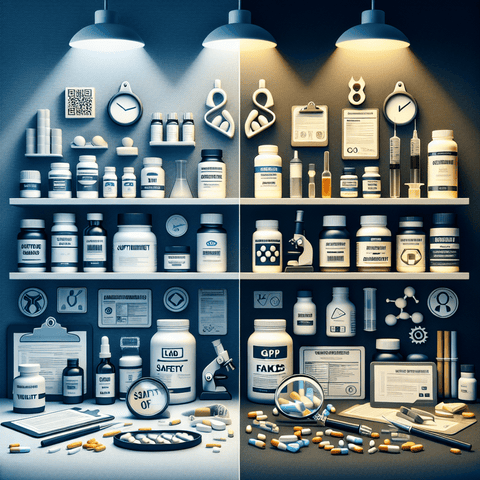Introduction
The global nutritional supplement industry has witnessed phenomenal growth in recent years. As more people become health-conscious and strive to meet their wellness goals—from supporting immune function to improving bone strength and boosting energy—dietary supplements have become a staple in many households. With products like vitamin C, magnesium, and omega-3 leading the way, the market is booming. However, navigating this industry safely has become an increasing concern, especially with the troubling rise of counterfeit supplements.
The internet and globalized trade have enabled unscrupulous sellers to distribute fake supplements that mimic the appearance of reputable brands. From individually-operated websites to big online marketplaces and even physical stores, fake supplements can be found virtually everywhere. These products may lack the listed ingredients, contain dangerous contaminants, or be entirely mislabeled—posing both health and financial risks for unsuspecting consumers.
The consequences of taking counterfeit supplements range from ineffectiveness to severe health issues like allergic reactions, toxicity, or interactions with medications. Moreover, falling for fake products wastes your money and undermines the trust in legitimate, high-quality supplements that do support good health when used appropriately.
In this comprehensive guide, you’ll learn how to identify counterfeit supplements before you buy them with a multi-pronged approach. We’ll cover the dangers of fake nutritional products, red flags to watch out for, authenticity-checking methods, and how to safely source your supplements—online and in-store. If you want to protect your health, avoid scams, and ensure you're getting real, high-quality nutrition, you're in the right place.
The Hidden Dangers of Fake Supplements in the Nutritional Market
Counterfeit supplements plague the global nutritional market, posing significant threats to public health. But what exactly constitutes a fake supplement? Broadly speaking, these are products that misrepresent their content, origin, or legitimacy in any way. They often try to imitate well-known brands, presenting themselves with similar labels and claims. Some may contain none of the advertised active ingredients, while others may actually include harmful substances like steroids, stimulants, or contaminants such as heavy metals and microbes.
There are several categories of counterfeit supplements:
- Outright Fakes: Completely fabricated products meant to look like legitimate brands but manufactured without proper quality control, testing, or active ingredients.
- Adulterated Products: Contain substances not listed on the label, including prescription drugs or banned substances.
- Expired or Repackaged Goods: Out-of-date stock that's rebranded to look current.
- Gray Market Imports: Sold through unauthorized parallel channels, often with different ingredients or labeling standards.
Real-world examples of dangerous counterfeit supplements have made headlines globally. In one notorious case, a U.S. distributor imported products containing sibutramine, a banned appetite suppressant linked to cardiovascular risk. Another incident involved contaminated omega-3 supplements found in unverified third-party stores, with oxidized oils that could do more harm than good.
Health risks from such products are serious:
- Allergic Reactions: Unlabelled allergens like shellfish or soy have been detected in fake multivitamins and protein powders.
- Toxicity: The inclusion of heavy metals like lead or mercury, especially in poorly regulated overseas brands.
- Ineffectiveness: Deceptive products may not contain the claimed dosages of vitamins, minerals, or botanical ingredients, rendering them useless for their intended purpose—whether it's supporting immunity or heart health.
What makes counterfeit supplements so hard to contain is the fragmented regulatory framework surrounding nutrition products. Unlike pharmaceuticals, dietary supplements don't undergo pre-approval by most national regulators. In the EU, while regulations exist under EFSA and DG SANTE, enforcement can be inconsistent. Online platforms are a particularly fertile ground for fraudsters, due to anonymity and limited oversight. Once fake supplements infiltrate global supply chains, they're hard to detect and remove.
This highlights the urgent need for consumers to become vigilant and proactive. Recognizing packaging inconsistencies, understanding labels, and verifying suppliers can go a long way in steering clear of fraudulent products. Your health isn't worth the gamble—especially when reliable options are readily available through reputable sources like Topvitamine’s vitamin D collection.
Red Flags to Watch Out for in Counterfeit Vitamins
Navigating the supplement aisle—virtually or in-store—requires more than just picking the brand with the flashiest label. When evaluating a product, several red flags can help you uncover whether the supplement is genuine or possibly a forgery.
1. Packaging Inconsistencies: Legitimate products are professionally manufactured with consistent branding. If you find bottles with poor print quality, smudged text, blurry logos, or mismatched fonts, be cautious. Typos or spelling errors on labels are often a dead giveaway of a counterfeiter's work.
2. Suspiciously Low Prices: Premium supplements backed by comprehensive research and quality assurance—such as vitamin K products—typically reflect their value in the cost. If a deal seems too good to be true, especially from unknown online sellers, it probably is. A 60-day supply of a patented magnesium blend retailing for €5.00 is a logical inconsistency that should raise eyebrows.
3. Variations from Previous Batches: If you’re familiar with a brand's product, check whether a new bottle differs significantly in capsule size, color, or smell. Most reputable brands maintain uniformity across batches. Any deviation could signal a counterfeit.
4. Tamper-Evident Seal Differences: Physical security features help ensure you're receiving a safe product. Compare shrink wraps, induction seals, or child-proof caps with previous purchases. A missing, broken, or switched-out seal is cause for scrutiny.
5. Batch Numbers and Expiry Dates: Legitimate supplements will always have a batch number and proper expiration date format printed clearly on the label. Batch identifiers help manufacturers trace production histories. Fakes often lack this traceability—which should concern any discerning buyer.
Here’s a quick table comparing characteristics for easy reference:
| Feature | Genuine Product | Counterfeit Product |
|---|---|---|
| Label Quality | High-res, consistent branding | Blurry, inconsistent fonts |
| Seal Integrity | Tamper-proof, intact | Missing, broken, inconsistent |
| Price Point | Comparable to similar products | Suspiciously low |
| Batch Info | Clear and traceable | Missing or faked |
Use these clues wisely, especially when purchasing high-demand supplements like vitamin C or omega-3 capsules, which are frequent targets of counterfeiters. Spending a few extra minutes to inspect labels and packaging can protect your long-term wellness.
A Step-by-Step Supplement Authenticity Check Guide
Being proactive is your best defense against counterfeit supplements. Here’s a structured approach for verifying a supplement's genuineness before you introduce it into your regimen.
Step 1: Research the Manufacturer
Start with a quick web search of the company’s brand. Reputable brands will have well-maintained websites showcasing their mission, founder stories, transparency commitments, and sourcing origins. If the company lacks any web presence or has only a vague "About Us” section, be cautious.
Step 2: Look for Third-Party Testing and Certifications
Trustworthy supplements are often certified by bodies like USP (U.S. Pharmacopeia), NSF International, or carry a GMP (Good Manufacturing Practice) stamp. While the EFSA doesn’t approve brand certifications, many reputable products also comply with ISO standards for food safety.
Step 3: Cross-Check with Manufacturer Tools
Some companies offer QR codes or batch lookup features directly on the package. Scanning a QR code may lead to certificates of analysis or batch-specific information. Make use of these options when available.
Step 4: Avoid Anonymous Sellers and Platforms
Avoid purchasing from poorly rated sellers, fly-by-night websites, or listings with broken grammar and unclear contact information. Look for trusted platforms such as certified supplement retailers that vet their products and handle supply chains responsibly.
Tools That Help:
- FDA Tainted Supplement List: Focused on the U.S. market, but helpful for identifying red flags.
- Supplement OWL (Online Wellness Library): Provides transparency on various brands, ingredients, and certifications.
Pros and Cons of Shopping Online vs. Certified Retailers
| Platform | Pros | Cons |
|---|---|---|
| Online Marketplaces (Amazon, eBay) | Convenience and price comparisons | Risk of third-party sellers, fake reviews |
| Certified Online Stores (Topvitamine.com) | Product authenticity, regulatory compliance, expert curation | Usually slightly higher cost |
Combining these steps forms a strong barrier against accidentally purchasing fake supplements. Authenticity should be non-negotiable when your health is at stake.
Spotting Fake Health Products Sold Online and In Stores
Spotting counterfeit supplements takes vigilance whether you're shopping online or in a brick-and-mortar store. Here's how to sharpen your senses for both environments.
Online Shopping Red Flags:
- Overloaded Keywords in Product Titles: “BEST Vitamin D IMMUNE DEFENSE SUPER POTENT 10000 IU” isn’t standard branding—it indicates spammy, suspicious marketing.
- Review Manipulation: Fake reviews often come in bursts, look overly generic, or contain repetitive phrases like “Excellent product!” without details. Use review validation tools where available.
- Lack of Seller Verification: If the product is “fulfilled by marketplace,” it could be stored alongside fakes. Investigate seller ratings and policies before proceeding.
In-Store Clues:
- Dusty or Poorly Shelved Stock: Randomized or disorganized displays may indicate older stock or unauthorized distribution.
- Unusual Pricing: Deep discounts on clearly premium brands without justification or promotion may suggest gray-market goods.
- Distributor Transparency: Ask staff who supplies their supplements and request invoices if you’re unsure. Legit stores won’t hesitate to clarify.
Questions to Ask:
- Is this product sourced directly from the manufacturer?
- Can you verify the expiration or batch data?
- How are supplements stored and rotated?
Retail consistency is a hallmark of genuine product availability. For instance, Topvitamine's curated vitamin D range offers a consistent selection known for quality assurance and supply chain transparency.
Use this advice to shop smarter—whether you're online or in-store—and avoid costly mistakes with your health.



